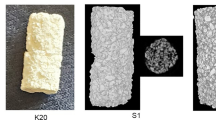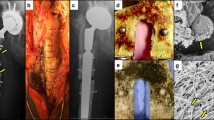Abstract
New antibiotics should ideally exhibit activity against drug-resistant bacteria, delay the development of bacterial resistance to them and be suitable for local delivery at desired sites of infection. Here, we report the rational design, via molecular-docking simulations, of a library of 17 candidate antibiotics against bone infection by wild-type and mutated bacterial targets. We screened this library for activity against multidrug-resistant clinical isolates and identified an antibiotic that exhibits potent activity against resistant strains and the formation of biofilms, decreases the chances of bacterial resistance and is compatible with local delivery via a bone-cement matrix. The antibiotic-loaded bone cement exhibited greater efficacy than currently used antibiotic-loaded bone cements against staphylococcal bone infections in rats. Potent and locally delivered antibiotic-eluting polymers may help address antimicrobial resistance.
This is a preview of subscription content, access via your institution
Access options
Access Nature and 54 other Nature Portfolio journals
Get Nature+, our best-value online-access subscription
$29.99 / 30 days
cancel any time
Subscribe to this journal
Receive 12 digital issues and online access to articles
$99.00 per year
only $8.25 per issue
Buy this article
- Purchase on Springer Link
- Instant access to full article PDF
Prices may be subject to local taxes which are calculated during checkout






Similar content being viewed by others
Data availability
The main data supporting the results in this study are available within the paper and its Supplementary Information. The raw and analysed datasets generated during the study are available for research purposes from the corresponding authors on reasonable request. Source data for the figures are provided with this paper.
References
Morris, K. Battle against antibiotic resistance is being lost. Lancet Infect. Dis. 7, 509 (2007).
Bush, K. et al. Tackling antibiotic resistance. Nat. Rev. Microbiol. 9, 894–896 (2011).
Teillant, A., Gandra, S., Barter, D., Morgan, D. J. & Laxminarayan, R. Potential burden of antibiotic resistance on surgery and cancer chemotherapy antibiotic prophylaxis in the USA: a literature review and modelling study. Lancet Infect. Dis. 15, 1429–1437 (2015).
Willyard, C. The drug-resistant bacteria that pose the greatest health threats. Nature 543, 15 (2017).
Wanted: a reward for antibiotic development. Nat. Biotechnol. 36, 555, (2018).
Doron, S. & Davidson, L. E. Antimicrobial stewardship. Mayo Clin. Proc. 86, 1113–1123 (2011).
Trampuz, A. & Widmer, A. F. Infections associated with orthopedic implants. Curr. Opin. Infect. Dis. 19, 349–356 (2006).
Sloan, M., Premkumar, A. & Sheth, N. P. Projected volume of primary total joint arthroplasty in the U.S., 2014 to 2030. J. Bone Jt. Surg. Am. 100, 1455–1460 (2018).
Moriarty, T. F. et al. Orthopaedic device-related infection: current and future interventions for improved prevention and treatment. EFORT Open Rev. 1, 89–99 (2016).
Li, B. & Webster, T. J. Bacteria antibiotic resistance: new challenges and opportunities for implant-associated orthopedic infections. J. Orthop. Res. 36, 22–32 (2018).
Arciola, C. R., Campoccia, D. & Montanaro, L. Implant infections: adhesion, biofilm formation and immune evasion. Nat. Rev. Microbiol.16, 397–409 (2018).
Gogia, J. S., Meehan, J. P., Di Cesare, P. E. & Jamali, A. A. Local antibiotic therapy in osteomyelitis. Semin. Plast. Surg. 23, 100–107 (2009).
Wright, J. A. & Nair, S. P. Interaction of staphylococci with bone. Int. J. Med. Microbiol. 300, 193–204 (2010).
Suhardi, V. J. et al. A fully functional drug-eluting joint implant. Nat. Biomed. Eng. 1, 0080 (2017).
Dowding, J. E. Mechanisms of gentamicin resistance in Staphylococcus aureus. Antimicrob. Agents Chemother. 11, 47–50 (1977).
Gardete, S. & Tomasz, A. Mechanisms of vancomycin resistance in Staphylococcus aureus. J. Clin. Invest. 124, 2836–2840 (2014).
Landersdorfer, C. B. et al. Pharmacokinetics and Pharmacodynamics of Antibiotics in Bone. In Bone and Joint Infections (Ed. Zimmerli, W.) 81–98 (Wiley, 2021).
Hooper, D. C. Mode of action of fluoroquinolones. Drugs 58, 6–10 (1999).
Acar, J. F. & Goldstein, F. W. Trends in bacterial resistance to fluoroquinolones. Clin. Infect. Dis. 24, S67–S73 (1997).
Kampranis, S. C. & Maxwell, A. The DNA gyrase-quinolone complex. ATP hydrolysis and the mechanism of DNA cleavage. J. Biol. Chem. 273, 22615–22626 (1998).
Aldred, K. J., Kerns, R. J. & Osheroff, N. Mechanism of quinolone action and resistance. Biochemistry 53, 1565–1574 (2014).
Hooper, D. C. & Jacoby, G. A. Mechanisms of drug resistance: quinolone resistance. Ann. N. Y. Acad. Sci. 1354, 12–31 (2015).
Blower, T. R., Williamson, B. H., Kerns, R. J. & Berger, J. M. Crystal structure and stability of gyrase–fluoroquinolone cleaved complexes from Mycobacterium tuberculosis. Proc. Natl Acad. Sci. USA 113, 1706–1713 (2016).
Conrad, S. et al. gyrA mutations in high-level fluoroquinolone-resistant clinical isolates of Escherichia coli. J. Antimicrob. Chemother. 38, 443–455 (1996).
Chan, P. F. et al. Structural basis of DNA gyrase inhibition by antibacterial QPT-1, anticancer drug etoposide and moxifloxacin. Nat. Commun. 6, 10048 (2015).
Diekema, D. J. et al. Survey of infections due to Staphylococcus species: frequency of occurrence and antimicrobial susceptibility of isolates collected in the United States, Canada, Latin America, Europe, and the Western Pacific region for the SENTRY Antimicrobial Surveillance Program, 1997–1999. Clin. Infect. Dis. 32, S114–S132 (2001).
Zimmerli, W. Clinical presentation and treatment of orthopaedic implant-associated infection. J. Intern. Med. 276, 111–119 (2014).
Kim, W. et al. A new class of synthetic retinoid antibiotics effective against bacterial persisters. Nature 556, 103–107 (2018).
Peeters, E. et al. Modulation of the substitution pattern of 5-aryl-2-aminoimidazoles allows fine-tuning of their antibiofilm activity spectrum and toxicity. Antimicrob. Agents Chemother. 60, 6483–6497 (2016).
Cramariuc, O. et al. Mechanism for translocation of fluoroquinolones across lipid membranes. Biochim. Biophys. Acta 1818, 2563–2571 (2012).
Vroom, J. M. et al. Depth penetration and detection of pH gradients in biofilms by two-photon excitation microscopy. Appl. Environ. Microbiol. 65, 3502–3511 (1999).
Lebeaux, D., Leflon-Guibout, V., Ghigo, J. M. & Beloin, C. In vitro activity of gentamicin, vancomycin or amikacin combined with EDTA or l-arginine as lock therapy against a wide spectrum of biofilm-forming clinical strains isolated from catheter-related infections. J. Antimicrob. Chemother. 70, 1704–1712 (2015).
McMahon. S. et al. Thermal necrosis and PMMA – a cause for concern? Orthop. Proc. 94-B, 64 (2012).
Hussain, S. et al. Antibiotic-loaded nanoparticles targeted to the site of infection enhance antibacterial efficacy. Nat. Biomed. Eng. 2, 95–103 (2018).
ASTM Standard, ASTM F451. in Annual Book of ASTM Standards Vol. 13.01 55–61 (ASTM International, 2000). https://www.astm.org
Kurtz, S., Ong, K., Lau, E., Mowat, F. & Halpern, M. Projections of primary and revision hip and knee arthroplasty in the United States from 2005 to 2030. J. Bone Jt. Surg. Am. 89, 780–785 (2007).
Bryan, A. J. et al. Irrigation and debridement with component retention for acute infection after hip arthroplasty: improved results with contemporary management. J. Bone Jt. Surg. Am. 99, 2011–2018 (2017).
https://www.fda.gov/regulatory-information/search-fda-guidance-documents/early-development-considerations-innovative-combination-products (US FDA, 2020).
Bistolfi, A., Ferracini, R., Albanese, C., Vernè, E. & Miola, M. PMMA-based bone cements and the problem of joint arthroplasty infections: status and new perspectives. Materials 12, 4002 (2019).
Stokes, J. M. et al. A deep learning approach to antibiotic discovery. Cell 181, 475–483 (2020).
FDA. (ed https://www.fda.gov/regulatory-information/search-fda-guidance-documents/principles-premarket-pathways-combination-products) (US FDA, 2022).
Entenza, J. M., Giddey, M., Vouillamoz, J. & Moreillon, P. In vitro prevention of the emergence of daptomycin resistance in Staphylococcus aureus and enterococci following combination with amoxicillin/clavulanic acid or ampicillin. Int. J. Antimicrob. Agents 35, 451–456 (2010).
Metzler, K., Drlica, K. & Blondeau, J. M. Minimal inhibitory and mutant prevention concentrations of azithromycin, clarithromycin and erythromycin for clinical isolates of Streptococcus pneumoniae. J. Antimicrob. Chemother. 68, 631–635 (2013).
Guy, R. H. H. & On, J. The determination of drug release rates from topical dosage forms. Int. J. Pharm. 60, R1–R3 (1990).
Rissing, J. P., Buxton, T. B., Weinstein, R. S. & Shockley, R. K. Model of experimental chronic osteomyelitis in rats. Infect. Immun. 47, 581–586 (1985).
Rouse, M. S. et al. Daptomycin treatment of Staphylococcus aureus experimental chronic osteomyelitis. J. Antimicrob. Chemother. 57, 301–305 (2006).
Acknowledgements
We thank S. Bandopadhayaya for his dedication in providing us with clinical perspectives and detailed explanations while conceiving the project. The authors from Vyome Therapeutics Limited acknowledge the funding support from the Biotechnology Industry Research Assistance Council, Department of Biotechnology (DBT), India, under a Small Business Innovation Research Initiative grant. H.L.J. discloses support for the publication of this study from the National Institutes of Health (grant numbers AR073135 and CA236702) and the Department of Defense (grant numbers PC180355 and CA201065).
Author information
Authors and Affiliations
Contributions
Sumana Ghosh and M.S. designed and performed the experiments, and contributed to the analysis of the results and the writing of the manuscript. R.S., S. Sadhasivam, A.B., A.N., S. Saini, N.T., H.S., S. Gupta, A.C., K.K.A., S.S.V., P.S., M.K.G., T.S. and A.P. contributed to the design and experimentation, and to the analysis of the results. Sudip Ghosh provided resources. Shamik Ghosh, H.L.J. and S. Sengupta designed and supervised the study, and contributed to the analysis of the results and the writing of the paper.
Corresponding authors
Ethics declarations
Competing interests
Sumana Ghosh, M.S., R.S., S. Sadhasivam, A.N., A.B., S. Saini, N.T., H.S., S. Gupta, A.C., M.K.G. and Shamik Ghosh are employees of Vyome Therapeutics Limited. Sumana Ghosh and Shamik Ghosh hold equity in Vyome Therapeutics Inc. S. Sengupta is a co-founder and board member of Vyome Therapeutics Limited, and owns equity in Vyome Therapeutics Inc. H.L.J. is a founder of Curer Inc. and holds equity in the company. S.S.V. and Sudip Ghosh declare no competing interests.
Peer review
Peer review information
Nature Biomedical Engineering thanks Ebru Oral, Liam Grover and the other, anonymous, reviewer(s) for their contribution to the peer review of this work.
Additional information
Publisher’s note Springer Nature remains neutral with regard to jurisdictional claims in published maps and institutional affiliations.
Extended data
Extended Data Fig. 1 Physicochemical characterization of VCD-077 impregnated PMMA beads.
(a-c) FT-IR spectrum of different groups (a) VCD-077, (b) PMMA, (c) VCD-077 impregnated PMMA at (40:1) with VCD-077 peaks 1 (3352.75 cm−1), 2 (3114.27 cm−1), 3 (1643.82 cm−1), 4 (1615.48 cm−1), 5 (1595.79 cm−1), 6 (1550.68 cm−1), 7 (1352.31 cm−1), 8 (1313.02 cm−1).(d) Release of VCD-077 from Smartset HV® (PMMA) bead at different drug:polymer ratio (1:40, 2:40 and 3:40) in pH 7.4 buffer. Data is represented as mean ± SD (n = 3). (e) Release of VCD-077 from Smartset HV® (PMMA) bead at different particle size from drug:polymer ratio (1:40) or (f) at different temperatures, in pH 7.4 buffer. Data is represented as mean ± SD (n = 3).
Supplementary information
Main Supplementary Information
Supplementary figures, tables and methods.
Source data
Rights and permissions
Springer Nature or its licensor holds exclusive rights to this article under a publishing agreement with the author(s) or other rightsholder(s); author self-archiving of the accepted manuscript version of this article is solely governed by the terms of such publishing agreement and applicable law.
About this article
Cite this article
Ghosh, S., Sinha, M., Samanta, R. et al. A potent antibiotic-loaded bone-cement implant against staphylococcal bone infections. Nat. Biomed. Eng 6, 1180–1195 (2022). https://doi.org/10.1038/s41551-022-00950-x
Received:
Accepted:
Published:
Issue Date:
DOI: https://doi.org/10.1038/s41551-022-00950-x
This article is cited by
-
Prospects and challenges for the application of tissue engineering technologies in the treatment of bone infections
Bone Research (2024)
-
Biofilm heterogeneity-adaptive photoredox catalysis enables red light-triggered nitric oxide release for combating drug-resistant infections
Nature Communications (2023)
-
Laser-induced antibacterial coating on the surface of an individual titanium membrane designed by a neural network
Optical and Quantum Electronics (2023)



